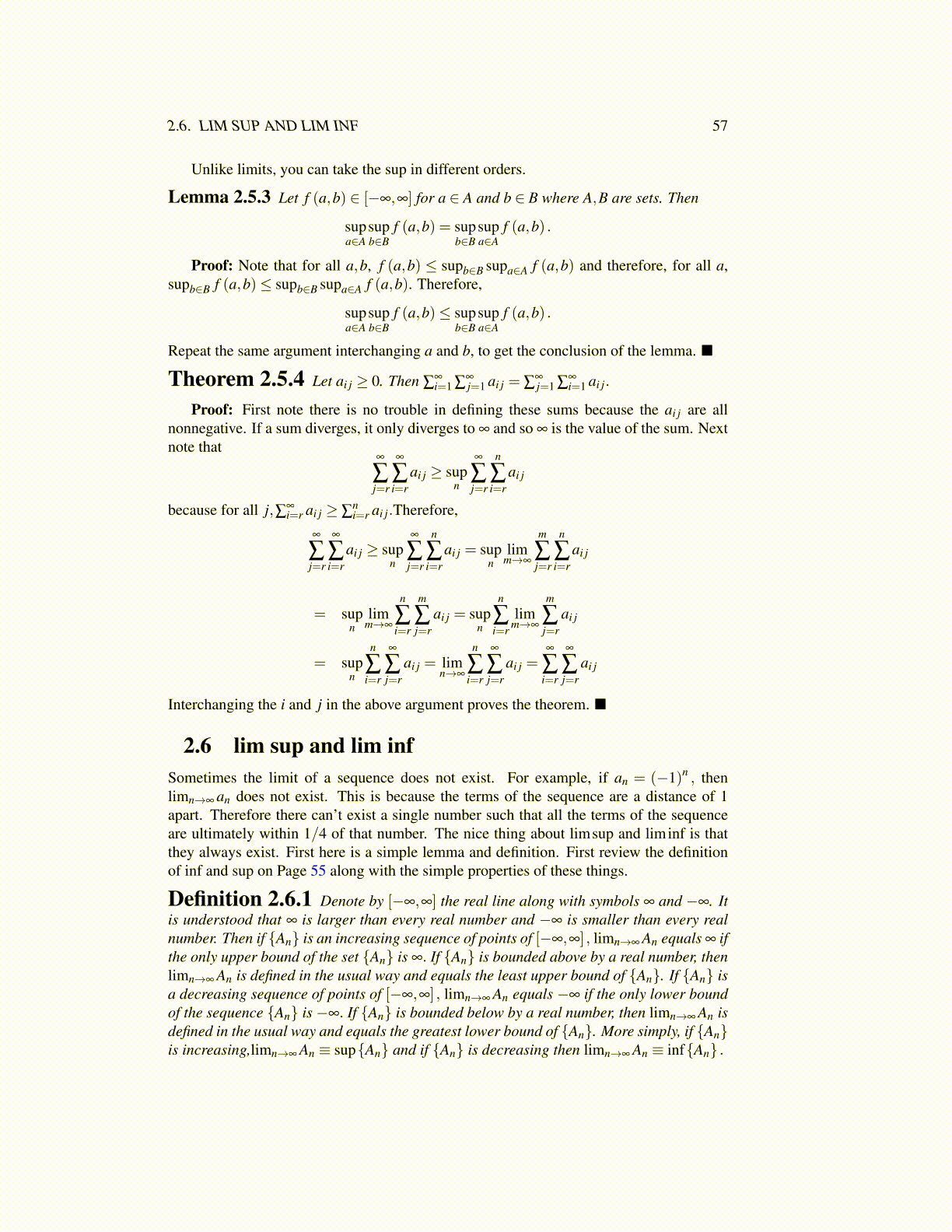
2.6. LIM SUP AND LIM INF 57
Unlike limits, you can take the sup in different orders.
Lemma 2.5.3 Let f (a,b) ∈ [−∞,∞] for a ∈ A and b ∈ B where A,B are sets. Then
supa∈A
supb∈B
f (a,b) = supb∈B
supa∈A
f (a,b) .
Proof: Note that for all a,b, f (a,b) ≤ supb∈B supa∈A f (a,b) and therefore, for all a,supb∈B f (a,b)≤ supb∈B supa∈A f (a,b). Therefore,
supa∈A
supb∈B
f (a,b)≤ supb∈B
supa∈A
f (a,b) .
Repeat the same argument interchanging a and b, to get the conclusion of the lemma. ■
Theorem 2.5.4 Let ai j ≥ 0. Then ∑∞i=1 ∑
∞j=1 ai j = ∑
∞j=1 ∑
∞i=1 ai j.
Proof: First note there is no trouble in defining these sums because the ai j are allnonnegative. If a sum diverges, it only diverges to ∞ and so ∞ is the value of the sum. Nextnote that
∞
∑j=r
∞
∑i=r
ai j ≥ supn
∞
∑j=r
n
∑i=r
ai j
because for all j,∑∞i=r ai j ≥ ∑
ni=r ai j.Therefore,
∞
∑j=r
∞
∑i=r
ai j ≥ supn
∞
∑j=r
n
∑i=r
ai j = supn
limm→∞
m
∑j=r
n
∑i=r
ai j
= supn
limm→∞
n
∑i=r
m
∑j=r
ai j = supn
n
∑i=r
limm→∞
m
∑j=r
ai j
= supn
n
∑i=r
∞
∑j=r
ai j = limn→∞
n
∑i=r
∞
∑j=r
ai j =∞
∑i=r
∞
∑j=r
ai j
Interchanging the i and j in the above argument proves the theorem. ■
2.6 lim sup and lim infSometimes the limit of a sequence does not exist. For example, if an = (−1)n , thenlimn→∞ an does not exist. This is because the terms of the sequence are a distance of 1apart. Therefore there can’t exist a single number such that all the terms of the sequenceare ultimately within 1/4 of that number. The nice thing about limsup and liminf is thatthey always exist. First here is a simple lemma and definition. First review the definitionof inf and sup on Page 55 along with the simple properties of these things.
Definition 2.6.1 Denote by [−∞,∞] the real line along with symbols ∞ and −∞. Itis understood that ∞ is larger than every real number and −∞ is smaller than every realnumber. Then if {An} is an increasing sequence of points of [−∞,∞] , limn→∞ An equals ∞ ifthe only upper bound of the set {An} is ∞. If {An} is bounded above by a real number, thenlimn→∞ An is defined in the usual way and equals the least upper bound of {An}. If {An} isa decreasing sequence of points of [−∞,∞] , limn→∞ An equals −∞ if the only lower boundof the sequence {An} is −∞. If {An} is bounded below by a real number, then limn→∞ An isdefined in the usual way and equals the greatest lower bound of {An}. More simply, if {An}is increasing,limn→∞ An ≡ sup{An} and if {An} is decreasing then limn→∞ An ≡ inf{An} .